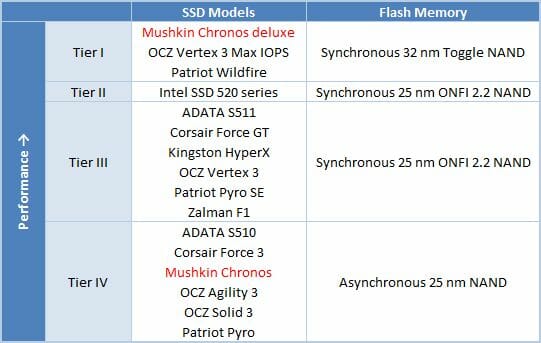Mushkin Chronos deluxe 240 GB and Chronos 240 GB Review

Once again we are checking out new SSDs based on second generation SandForce controller. Using typical components, Mushkin Enhanced managed to create two very attractive products.
Our Intel SSD 520 review was supposed to be the last in a series of reports about solid state drives based on second-generation SandForce controllers. Numerous tests had convinced us that the performance of different modifications of SandForce-based SSDs is determined by their flash memory type. Intel’s SSD featured optimized firmware but couldn’t show anything special in our tests, either. So, it looks like we can’t expect anything sensational from the SandForce realm until the next generation of controllers. We doubt that some SSD maker can deliver something very special under the SandForce Driven program.
Still, we can’t avoid testing SandForce-based SSDs. They are highly popular and their makers keep on sending their samples for us to test. Moreover, such an SSD can stand out among its competitors with its accessories, attractive price or warranty terms, even though its performance is predictable. That’s why we will continue our reviews of this large SSD family. Today we are going to tell you about two products from Mushkin Enhanced: Chronos and Chronos deluxe.
A respectable maker of overclocker-friendly memory from the United States, Mushkin Enhanced has never been aggressive in its marketing, so its brand is largely known only to enthusiasts and geeks. It’s not easy to win this target audience, but Mushkin has succeeded. Its products have always been high quality and its tech support, up to the mark.
Following many other manufacturers of premium memory modules, Mushkin has recently taken an interest in solid state drives. The company collaborates with SandForce, which is now a division of LSI, and receives from it a full package of technologies necessary for mass production of SSDs. As a result, Mushkin Enhanced now offers conventional SSDs which appeal to the user with their attractive pricing and reputable brand.
Closer Look at Mushkin Chronos deluxe 240 GB and Mushkin Chronos 240 GB
The Chronos and Chronos deluxe are in fact the only SSD products Mushkin Enhanced offers right now, although most other companies that collaborate with SandForce give you a choice of three SSD varieties with the SF-2281 controller: with asynchronous flash, with synchronous ONFI flash and with NAND flash with Toggle DDR interface.
The Chronos deluxe is the faster of the two series and employs NAND flash memory with Toggle Mode interface. The Chronos is a more affordable alternative with asynchronous flash. It features a more attractive cost per gigabyte and offers high performance, although not as high as with the Chronos deluxe. Mushkin provided us 240GB models from both series.
The SSDs have identical packaging. They are packed into blister wraps along with their accessories and are shipped in small cardboard boxes. Besides marketing slogans and promotions of the company’s memory kits and USB flash drives, there is no useful information on the box.
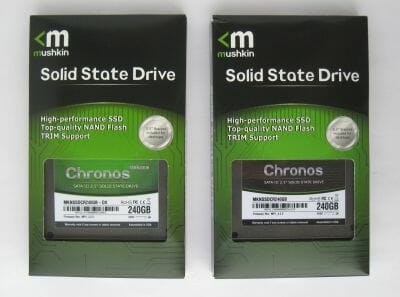
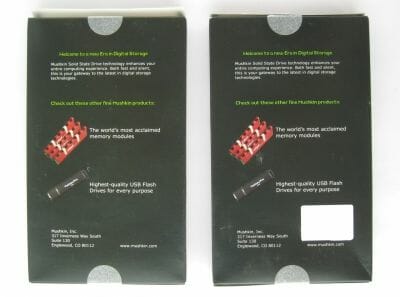
The accessories to each model are identical: a 3.5-inch adaptor for installing the 2.5-inch SSD into a 3.5-inch disk bay and some mounting screws. There are no software or user manuals here.
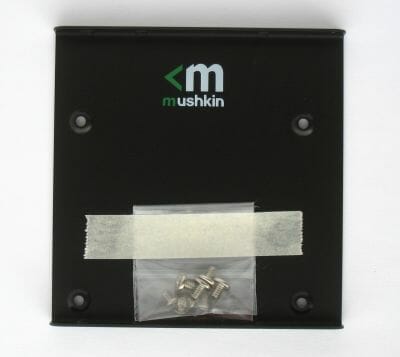
The exterior design is ordinary enough, yet stylish in some ways. The case has a rough coating and lacks warranty stickers. Besides the product name, barcode and part number, the label informs you that the SSD was manufactured in the United States.
Mushkin Enhanced Chronos deluxe 240 GB
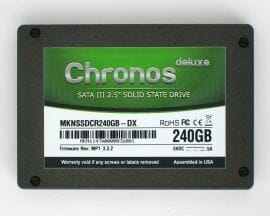
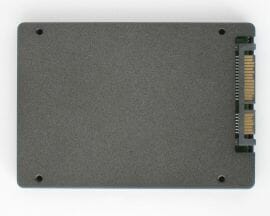
Mushkin Enhanced Chronos 240 GB
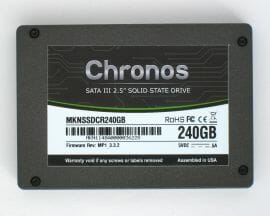
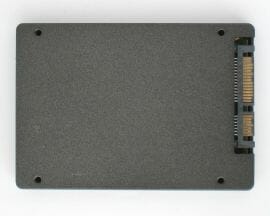
So, the Mushkin products have rather appealing looks. Let’s now see what’s inside them as that’s far more important for end users.
The Mushkin Chronos deluxe contains 32nm flash memory from Toshiba with Toggle Mode DDR interface. Marked as Toshiba TH58TAG7D2FBAS9, these are 128-gigabit chips with four 32-gigabit semiconductor dies. Thus, the SSD owes its high performance not only to its fast flash memory but also to the 8-way interleave in each channel (there are 64 flash devices per eight controller channels).
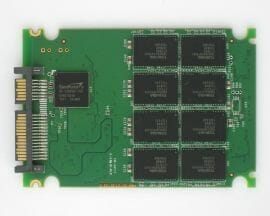
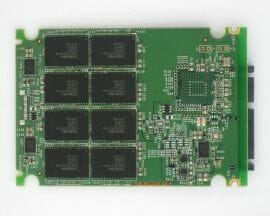
So, the Mushkin Chronos deluxe features the fastest version of the second-generation SandForce platform. It’s similar to such products as OCZ Vertex 3 Max IOPS or Patriot Wildfire. An interesting fact about the Chronos deluxe is that its controller modification is SF-2282. The chip has a slightly different packaging than the standard SF-2281 and supports up to 128 NAND devices, therefore Mushkin has the opportunity to offer a unique 480GB model in this series.
The second hero of our today’s article, Mushkin Chronos, didn’t have any surprises for us up its sleeve. Take a look, this is the PCB we found inside this SSD:
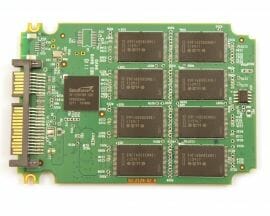
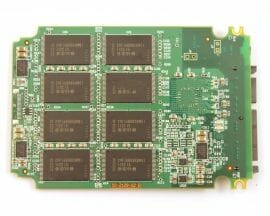
As we have expected, Mushkin Chronos is equipped with inexpensive memory supporting asynchronous interface. In our specific sample we found sixteen Intel 29F16B08CAMEI chips, although we believe there are also units using similar memory from Micron. Each chip like this is a 128 Gbit chip with two MLC flash dies inside manufactured using contemporary 25 nm process. It means that despite the limited bandwidth of the asynchronous flash memory, the eight-channel SF-2281 controller in Chronos can use four-way interleaving, which may in a way make up for the low performance of the NAND-devices. So, in terms of hardware configuration, Mushkin Chronos is similar to such SSDs as OCZ Agility 3 or Corsair Force 3.
Both the ordinary and deluxe versions of the Chronos reserve 14% of their total storage capacity for RAISE technology (Redundant Array of Independent Silicon Elements), so the user-accessible capacity is 240 gigabytes. Although SandForce allows increasing the useful capacity to 256 GB with the latest firmware, ADATA is so far the only manufacturer to use this opportunity.
The Mushkin SSDs have firmware 3.3.2 which is supposed to be free from the problems the SF-2281 controller used to have in Windows.
The following table lists the official specs of the 240GB Chronos and Chronos deluxe:
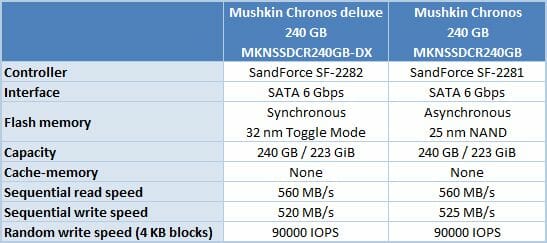
Take note that Mushkin claims its products, especially the Chronos with asynchronous memory, to be indecently fast. It doesn’t mean that these SSDs are indeed faster than other SandForce-based products. It’s just some bragging from the company’s marketing department.
Like the majority of SSD makers, Mushkin provides a 3-year warranty for its SSDs.
Testbed Configuration
All SSDs were performed in a testbed built around an Intel H67 based mainboard. This chipset provides support for two SATA 6 Gbit/s ports, which we use to connect the tested SSDs.
We are going to compare the performance of Mushkin Chronos deluxe and Mushkin Chronos against several other solid state drives of the similar storage capacity that support SATA 6 Gbps interface. Among them is a product on Marvell 88SS9174 controller – Corsair Performance Pro, as well as a few close relatives of our today’s heroes – SSDs on the second-generation SandForce controller. Among them are a typical SSD with 32 nm Toggle NAND (OCZ Vertex 3 Max IOPS), a typical SSD with 25 nm synchronous ONFI memory (Corsair Force Series GT), a typical SSD with 25 nm asynchronous memory (Corsair Force Series 3) and a unique Intel SSD 520 Series using regular 25 nm synchronous memory but featuring exclusive firmware.
Overall our testbed was configured as follows:
- Intel Core i5-2400 (Sandy Bridge, 4 cores, 3.1 GHz, EIST and Turbo Boost turned off);
- Foxconn H67S mainboard (BIOS A41F1P03);
- 2 x 2 GB DDR3-1333 SDRAM DIMM 9-9-9-24-1T;
- Crucial m4 256 GB system disk (CT256M4SSD2);
- Tested SSDs:
- Corsair Force 3 Series 240 GB (CSSD-F240GB3-BK, firmware version 1.3.3);
- Corsair Force GT Series 240 GB (CSSD-F240GBGT-BK, firmware version 1.3.3);
- Corsair Performance Pro 256 GB (CSSD-P256GBP-BK, firmware version 1.0);
- Intel SSD 520 240 GB (SSDSC2CW240A3K5, firmware version 400i);
- Mushkin Chronos deluxe 240 GB (MKNSSDCR240GB-DX, firmware version 3.3.2);
- Mushkin Chronos 240 GB (MKNSSDCR240GB , firmware version 3.3.2);
- OCZ Vertex 3 Max IOPS 240 GB (VTX3MI-25SAT3-240G, firmware version 2.15).
- Microsoft Windows 7 SP1 Ultimate x64
- Drivers:
- Intel Chipset Driver 9.3.0.1019;
- Intel Graphics Media Accelerator Driver 15.22.54.2622;
- Intel Rapid Storage Technology 11.1.0.1006.
Performance
Random and Sequential Reading/Writing
We use CrystalDiskMark 3.0.1 benchmark to test the random- and sequential read and write speed. This benchmark is convenient to work with as it can measure the speed of an SSD with both incompressible random and fully compressible recurring data. This feature is important for testing SSDs based on SF-2281/2282 controller, which tries to compress the data before writing it into memory. So, there are two numbers in the diagrams below that reflect the maximum and minimum SSD speed. The real-life performance of an SSD is going to be in-between those two numbers depending on how effective the controller data compression is.
Note that the performance tests in this section refer to SSDs in their “Fresh Out-of-Box” state (FOB). No degradation could have taken place yet.
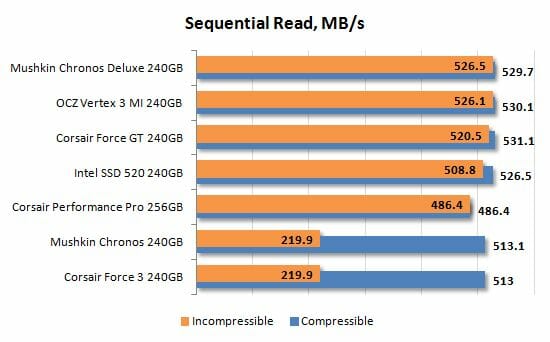
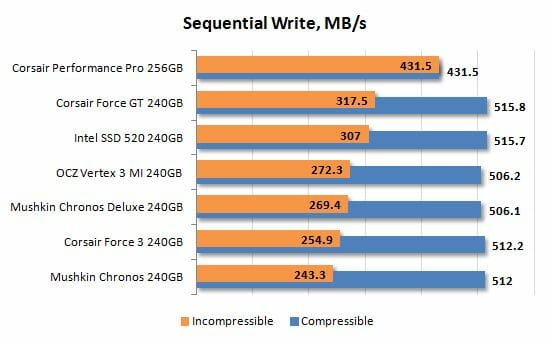
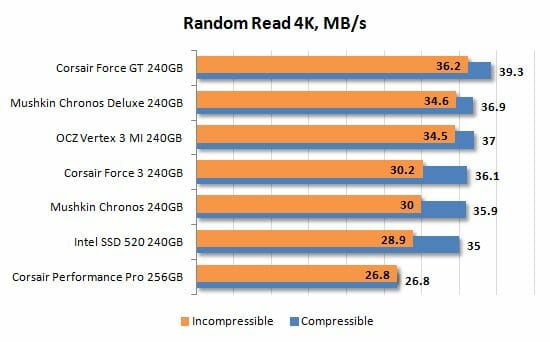
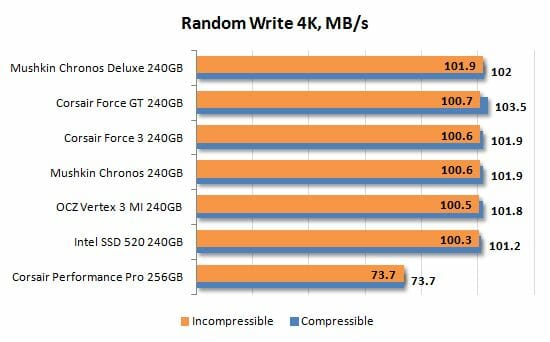
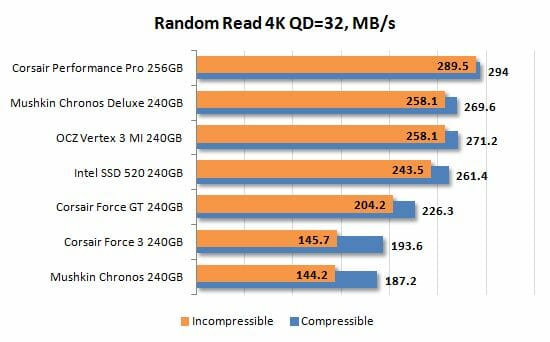
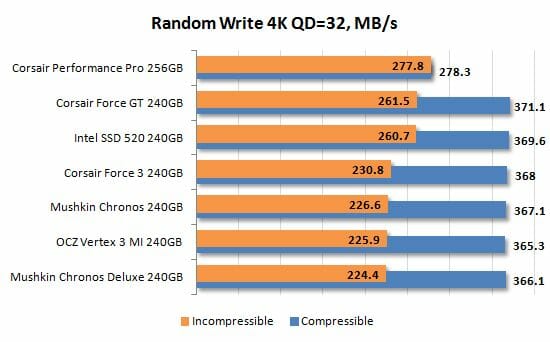
It’s not the first time we test SSDs with SF-2281/2282 controllers, so we could easily predict the outcome. The Mushkin Chronos deluxe using the same flash memory as the OCZ Vertex 3 Max IOPS, they deliver similar performance in our tests. The results of the Mushkin Chronos indicate that it employs asynchronous flash memory because its performance is comparable to that of the Corsair Force 3. Thus, there is only one exception to the rule that the flash memory type is the key factor in SSD performance. It’s the Intel SSD 520 series with its exclusive firmware.
Degradation and Steady-State Performance
Unfortunately, SSDs are not always as fast as in their “fresh” state. In most cases their performance goes down after some time and in real life we deal with completely different write speeds than what we see on the diagrams in the previous chapter of our review. The reason for this phenomenon is the following: as the SSD runs out of free pages in the flash memory, its controller has to clear memory page blocks before saving data into them, which causes substantial delays. Although, modern SSD controllers can alleviate the performance drop by erasing unused flash memory pages ahead of time, when idle. They use two techniques for that: idle-time garbage collection and TRIM.
Of course, users are more interested in the consistent performance of their SSDs over a long period of time rather than the peak speed they are going to see only during the initial short-term usage period, while the drive is still “fresh”. The SSD makers, however, declare the speed characteristics of “fresh” SSDs for marketing reasons. That’s why we decided to test the performance hit that occurs when a “fresh” SSD becomes a “steady” one.
To get a complete picture of SSD performance degradation we ran special tests based on the SNIA SSSI TWG PTS (Solid State Storage Performance Test Specification) methodology. The main idea of this approach is to measure write speed consecutively in four different cases. First we measure the “fresh” SSD speed. Then we measure the speed after the SSD has been fully filled with data twice. The third test occurs after a 30-minute break during which the controller can partially restore performance by running the idle-time garbage collection. And finally, we measure the speed after issuing a TRIM command.
We ran the tests in synthetic IOMeter 1.1.0 RC1 benchmark, where we measured random write speed when working with 4 KB data blocks aligned to flash memory pages at 32 requests queue depth. The test data were pseudo-random.
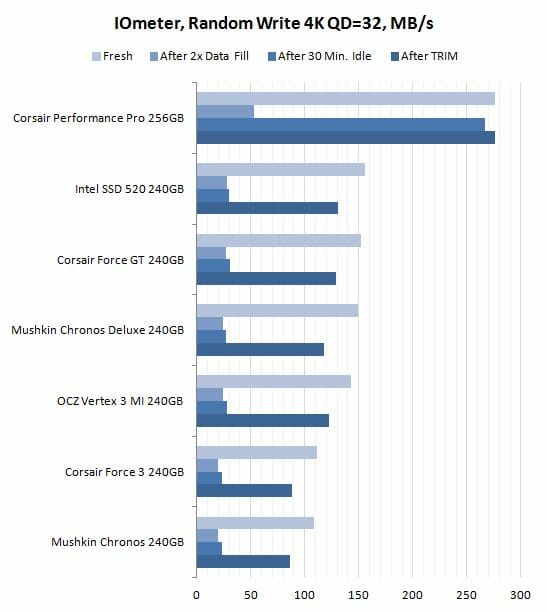
The two SSDs from Mushkin Enhanced behave like any other second-generation SandForce-based product in this test. Garbage collection is not effective at all. They can only restore their performance by means of the TRIM command. However, even TRIM can’t restore their performance to the original level. The steady-state speed of the Mushkin SSDs is going to be somewhat lower than what they can show in their fresh out-of-box state. This only affects the speed of writing, though. The following diagrams show the difference as measured with Crystal Disk Mark 3.0.1. We use random data here.
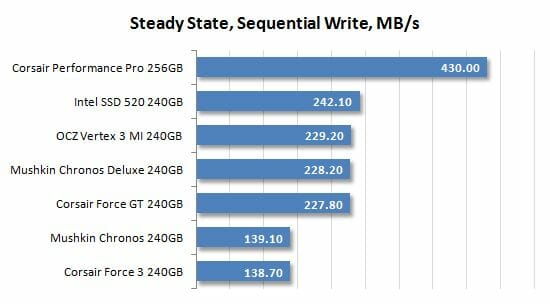
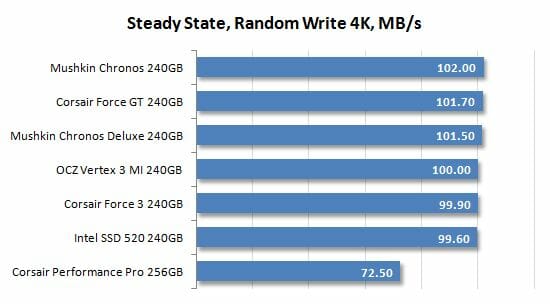
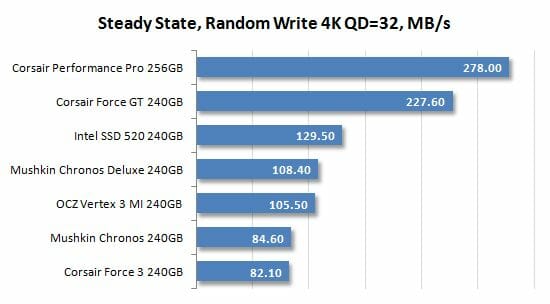
If you want an SSD which doesn’t slow down over time, you should consider products based on the Marvell 88SS9174 controller. That’s why such SSDs offer a higher write speed than their SandForce-based counterparts when filled with data. The Mushkin SSDs are no different from their SandForce cousins: the Chronos deluxe is comparable to the OCZ Vertex 3 Max IOPS whereas the ordinary Chronos is similar to the Corsair Force 3.
Futuremark PCMark 7
The popular PCMark 7 contains an individual disk subsystem benchmark. It is not a synthetic test, but is based on real-life applications. This benchmark reproduces typical disk usage scenarios and measures how fast they are completed in popular applications. Moreover, the disk access commands are not executed as a steady uninterrupted flow, but in a more realistic manner – with certain pauses caused by the need to process the data. The benchmark generates an overall disk subsystem performance rating as well as speed readings in MB/s in individual usage scenarios. Note that the absolute speed in these scenarios is not too high because of the above mentioned pauses between individual input/output operations. In other words, PCMark 7 shows you the speed of the disk subsystem from the application’s point of view. Numbers like that show us not only the pure performance of an SSD, but mostly how big of a performance gain a certain SSD can guarantee in real life.
We ran PCMark 7 on “steady” SSDs, which is what they are going to be in actual computer systems most of the time. Their performance in this case is affected not only by their controller or flash memory speed but also by the efficiency of their internal algorithms that fight performance degradation.
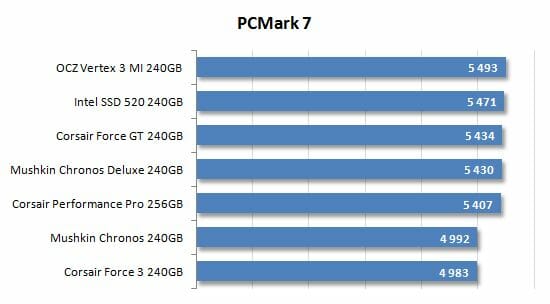
The PCMark 7 score is a good guide for users who want to see how SSDs perform in typical applications without delving into technical details. The Chronos turns out to be close to the Corsair Force 3, indicating once again that it is not a fast SSD. The Chronos deluxe is for some reason slower than the OCZ Vertex 3 Max IOPS and closer to the Corsair Force GT. The difference is a mere 1%, though.
Let’s check out the individual tests to get a more detailed picture of what our SSDs are capable of under various types of operational load:
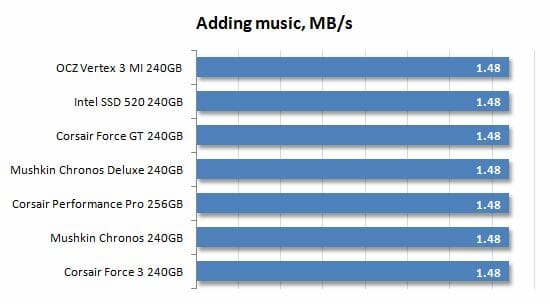
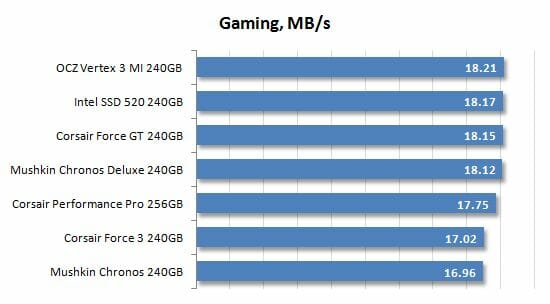
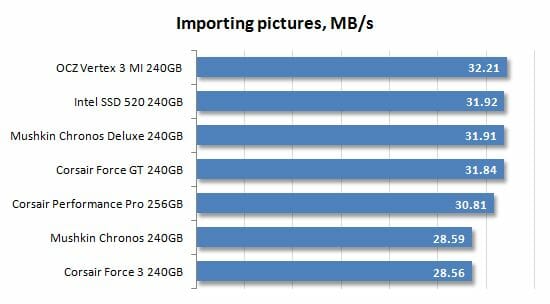
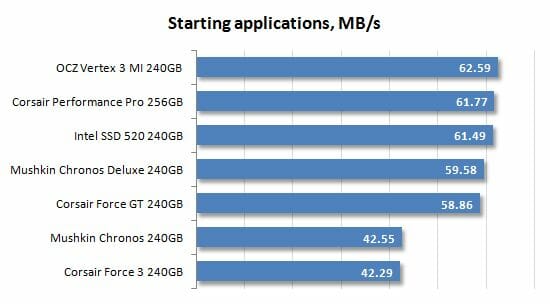
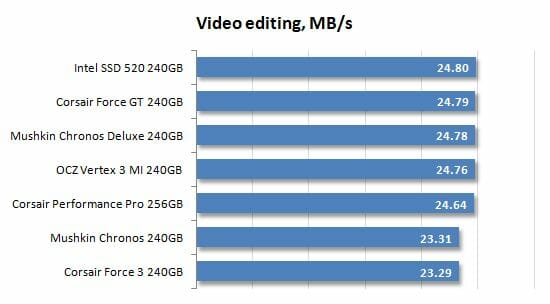
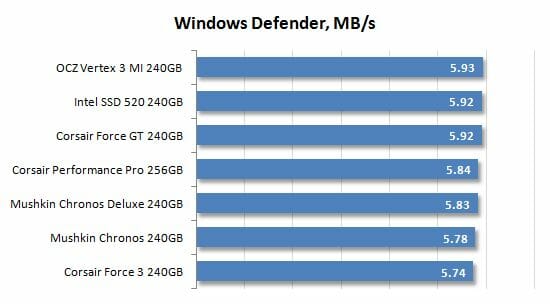
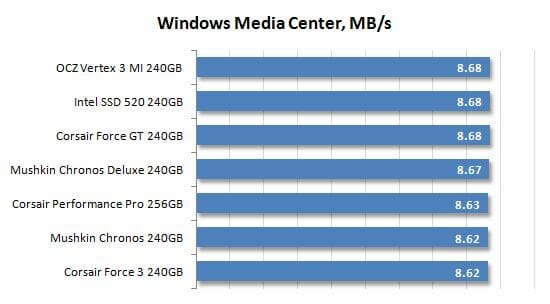
The diagrams show that the Chronos deluxe has a lower PCMark 7 score than the OCZ Vertex 3 Max IOPS, which uses the same hardware, because of the Starting Applications scenario where its performance drops to the level of SSDs with synchronous flash. As for the Chronos model, it is expectedly as fast as the Corsair Force 3.
Intel NAS Performance Toolkit
Intel NASPT is another disk sub-system test that uses real-life usage scenarios. Like PCMark 7, Intel NASPT reproduces predefined disk activity traces and measures how fast they are executed. However, the default traces are designed for network attached storage devices rather than for SSDs. Therefore during our test session we replace them with the specially developed SSD Benchmarking Suite which offers more relevant usage scenarios such as compressing and decompressing files, compiling large projects, copying files and folders, loading 3D game levels, installing software, batch-processing photos, searching a digital library for data, mass-launching applications, and transcoding video.
Like PCMark 7, this benchmark gives us a true-to-life illustration of disk subsystem performance. Here the SSDs are again tested in their “steady” state.
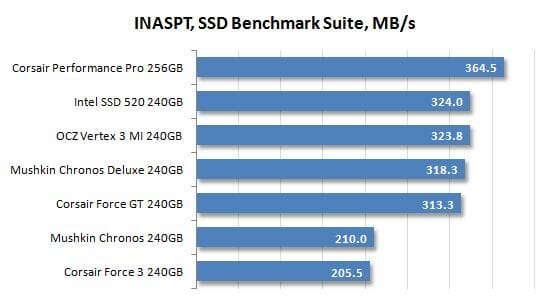
The Mushkin SSDs perform just as expected in this test, too. The Chronos is at the bottom of the diagram as it employs rather slow asynchronous flash. The Chronos deluxe is, on the contrary, among the fastest SSDs with second-generation SandForce controller. Its high performance is due to its Toggle Mode flash from Toshiba with 8-way interleave.
The detailed INASPT results help us see what usage scenarios are the most suitable for our today’s testing participants. Take note that the data-transfer rate is higher than the SATA III interface bandwidth in some subtests. That’s because INASPT is a high-level test that uses standard Windows functions to access the disk subsystem. As a result, the OS caching mechanisms also affect the results.
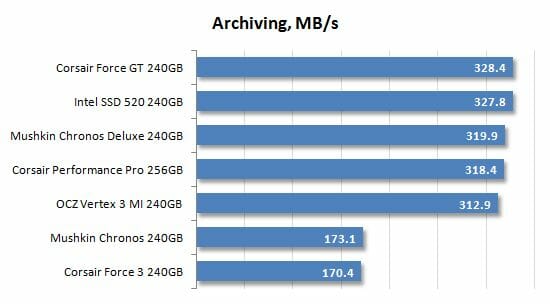
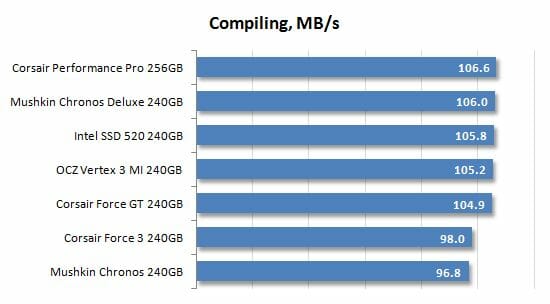
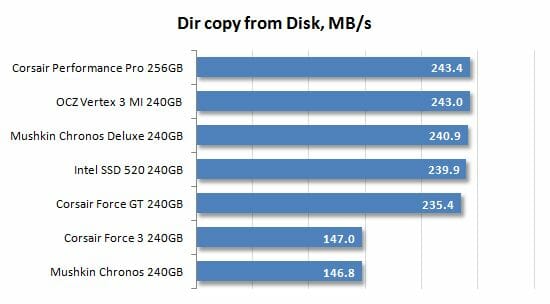
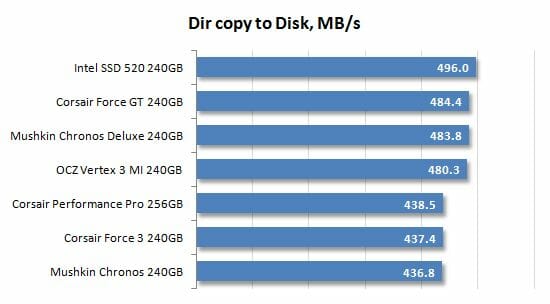
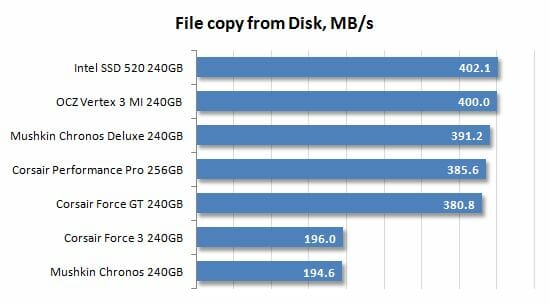
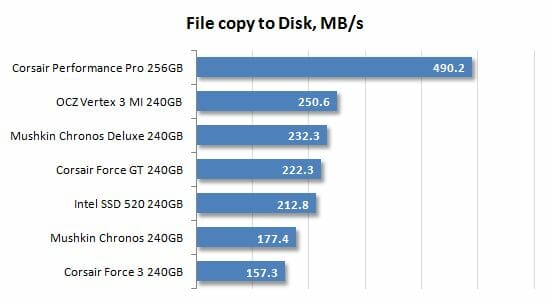
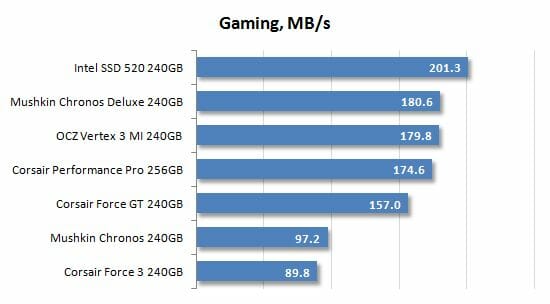
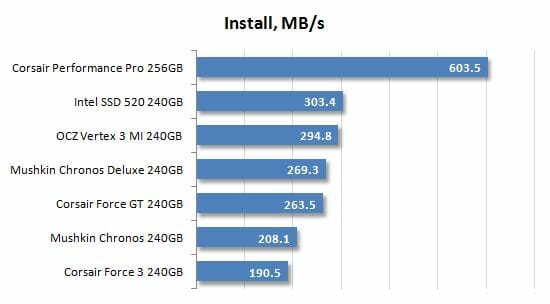
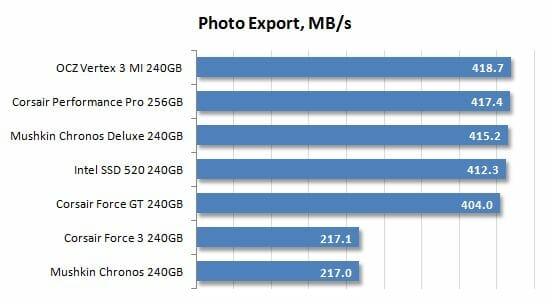
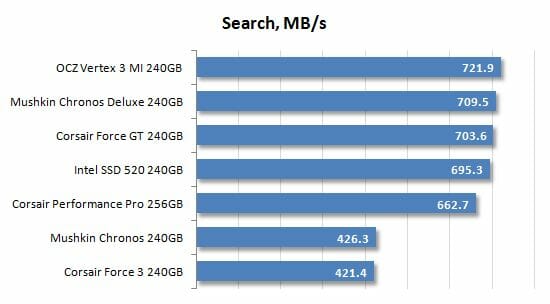
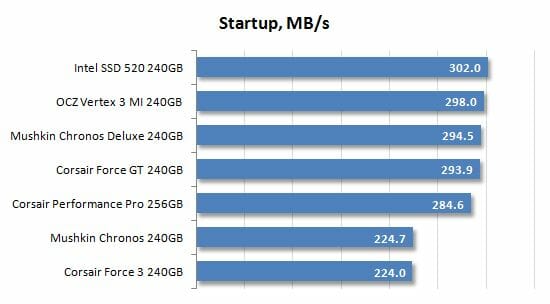
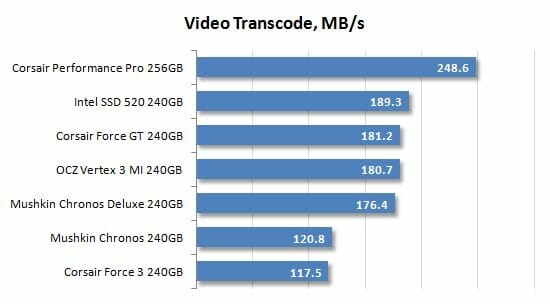
INASPT prefers the Intel SSD 520 with its specially optimized firmware. The Chronos deluxe is slower than the Intel, yet also delivers high performance. It finds itself among the leaders in some scenarios such as compilation or search. The ordinary Chronos is not so fast, but it is not supposed to set any performance records. Its advantage is in its price rather than speed.
Conclusion
The Chronos and Chronos deluxe SSDs from Mushkin Enhanced that we’ve just tested seem to be typical representatives of the second-generation SandForce platform. The Chronos deluxe is positioned as a high-performance solution as it uses 32nm flash memory from Toshiba with Toggle Mode DDR interface. The Chronos is a slower variant (if we can apply the word slow to modern SSDs) and uses asynchronous NAND flash.
The SSDs from Mushkin Enhanced hardly differ from other products in their speed characteristics. Many other brands offer similar SSDs with the same controllers, memory and firmware. However, there is one special advantage that the Mushkin solutions have. Both the Chronos and the Chronos deluxe turn out to be among the most affordable SSDs in their respective categories. The 240GB Chronos is very close to the psychological barrier of $1 per gigabyte. The Chronos deluxe is good in this respect, too. It can be found selling at a cheaper price than some SandForce-based SSDs with synchronous ONFI flash and lower performance!
So, if you don’t have any prejudice against SandForce technologies, these Mushkin SSDs can make a good buy, especially as Mushkin is a reputable American firm with high-quality tech support. The fast and attractively priced Mushkin Enhanced Chronos deluxe deserves our Recommended Buy award:

Summing up our tests of SandForce-based SSDs, we put the results into a single table where all the products are sorted in groups with the same performance. Our experience suggests that there are four such groups that differ greatly from each other. Within each group, however, SSDs are very close to each other in performance.
